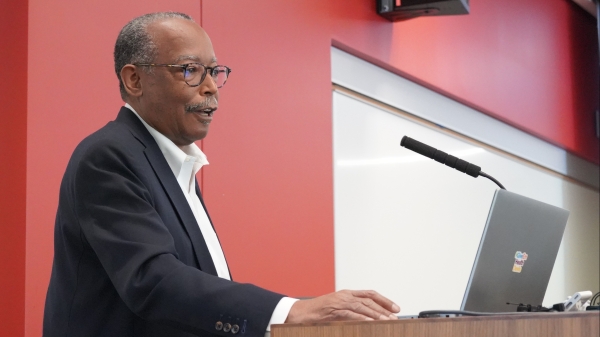Will Boomers make the health-care system go bust?
Public discussion to address America's aging population and what it means to nation's health infrastructure

Most Baby Boomers and Gen Xers have generally accepted the idea that Social Security might fold in their lifetime. Will our health-care system share the same fate if it isn’t properly addressed?
That’s a question a group of national and local experts will attempt to answer at an April 26 panel, “Will the Aging of America Bankrupt the Health Care System?” Sponsored by the Health Futures Council at ASUThe Health Futures Council at ASU serves the university through the Office of the President and is made up of experienced leaders across a broad continuum of health and business with a passion for improving health and access to care. They lend their expertise to provide context, advice and resources to further the work of ASU faculty and leadership. and produced by Zócalo Public SquareZócalo Public Square, an affiliate of Arizona State University, is a not-for-profit ideas exchange that blends live events and humanities journalism. , the free public event will start at 7 p.m. Tuesday at the Arizona Science Center in Phoenix.
Moderated by Wall Street Journal health reporter Anna Wilde Matthews, the panel includes Marjorie Baldwin, a health economist in the W. P. Carey School of Business at Arizona State University; Keith Dines, CEO of Arizona Integrated Physicians; G. Lawrence Atkins, executive director of Long-Term Quality Alliance; and John Rother, CEO of the National Coalition on Health Care in Washington, D.C.
The provocatively titled panel was designed to provoke discussion and spur possible action, said the event’s organizer.
“The Health Futures Council feels a real passion to make a difference in that they see a lot that’s wrong with the health-care system and want to make it better,” said Dr. Mitzi Krockover, director of the Health Futures Council at ASU.
“We felt this was a very salient issue — one that affects everyone involved in the system including providers, payers and consumers — and will have repercussions for future generations. We hope that shining a light on this topic will lead to productive conversations and innovative solutions.”
A perfect storm of aging demographics, longer life expectancies, shortages of physicians and other health professionals, disease epidemics and dwindling resources is threatening our nation’s health-care infrastructure. And according to a recent U.S. Census Bureau report, the world is about to see a first — more older people than young children.
In the next five years, the proportion of people older than 65 will make up an estimated 15.6 percent of the U.S. population. The proportion of older adults will be more than double the proportion of children younger than 5.
A poorer and more diverse generation of Americans will be supporting the health of the Baby Boom generation who will be seeking more health care as they age. The trustees of Medicare predict a day of financial reckoning is coming and estimate that the trust fund will run out of assets by 2030.
This all leads to one simple question: How can the American health-care system continue to do business as usual as the nation’s demographics change so dramatically?
It simply cannot, say the experts.
“It’s not a crisis yet, but it’s easier to fix if it’s addressed early rather than wait until it becomes a crisis,” said Baldwin, who is also the academic director for Public Health Programs in the College of Health Solutions at ASU. “Running up the national debt even further is not a good plan. It’s better to find ways to fix the system now.”
Baldwin said one problem with our health-care system is that the American public is used to health-insurance coverage that pays almost all the costs of health care. Even though it sounds good, it could have detriments.
“I often give this example to my students — we have insurance on our cars in case there’s a bad accident and the car is totaled. We don’t have insurance for little things like oil changes or routine maintenance,” Baldwin said. “Insurance is designed to protect us from catastrophic events, not things that are routine events and predictable. We basically get all of our health care for free and so people don’t pay attention to what they’re consuming, what price they’re paying or if they’re getting good value.”
Baldwin suggests individual health savings accounts could not only cut down on overall health-care costs but could put consumers in the driver’s seat.
Rother said pharmaceutical companies currently are in the driver’s seat, and prescription drug costs are putting our nation’s health care on a collision course with insolvency.
“The inflation of drugs is creating the immediate crisis, and that’s because we are allowing the drug companies to charge whatever they want,” Rother said. “Companies like Pfizer raised its prices across the board by 20 percent this year. If that continues, it will drive the system into the ground.”
Rother believes Social Security is a fairly easy fix compared with Medicare, given the rising costs of health care. He said we need to invest more in health education — obesity and diabetes are at epidemic levels — and get Washington to start thinking big picture and long term.
“We have a system now where politicians are focused on the next two years, and the result is that we pass the buck onto our future generations instead of getting things under control now,” Rother said. “It’s hard to make long-term changes in an election cycle. It’s discouraging.”
Other factors are also at play, said panelist Atkins, including personal responsibility for one’s own health, the aging population putting stress on the system, and lack of discipline in the health-care profession.
“We run a very, very expensive health-care system in this country, and we run it very, very inefficiently,” said Atkins. “We’ve built up a very elaborate system in this country. Some of it is high tech. Some of it is fancy and expensive. Some of it is redundant. So we’re carrying a very expensive load.”
Atkins said some states are actually making aggressive changes on the legislative level to wipe out inefficiencies and rein in the costs. Other hard decisions need to be made by individuals, including difficult ones when the end is near.
“Hospice and palliative care is a covered benefit of Medicare, but often people in these circumstances need to have control over their lives and not become a victim of highly trained medical professionals who have a view of how things should be done,” Atkins said. “The more person-centric we can make our system, then it’s going to be easier all the way around with less costs.”
The experts agreed that taking a look at another health-care system would be a good idea, but certainly not the cure-all.
Rother pointed to Germany, Canada, Sweden, Denmark, Singapore and Japan as having excellent systems that serve their aging populations well.
“They have a range of different approaches, but all of their health-care systems are much less expensive, yet their results and outcomes are just as good or even better than the United States,” Rother said.
On the other hand, Baldwin said, “There are three things a health-care system should do: provide access, to quality care, at a reasonable cost. It’s easy to get two of them but difficult to get all three. No health-care system in the world has solved that problem.”
Baldwin said there are trade-offs between the three objectives, and different countries make different trade-offs. What works in other countries may not work in the United States, where we have a large, diverse and fiercely independent population.
“If you buy into a one-payer system, then you will be giving up some sort of control to the government. Ultimately someone will be rationing your health care for you,” Baldwin said. “They might decide if they’re going to cover a particular Alzheimer’s drug or tell you what kind of surgery you can or can’t have. I cannot imagine Americans would be willing to live under a system like that.
“It’s far better to put the decision-making power in the hands of the consumers. Then they can decide what’s of value to them.”
If you go
What: “Will the Aging of America Bankrupt the Health Care System?” roundtable discussion.
Where: Arizona Science Center, 600 E. Washington St., Phoenix.
When: 7 p.m. Tuesday, April 26.
Cost: Admission is free and open to the public; registration is required. RSVP here.
Information: www.zocalopublicsquare.org.
More Health and medicine

College of Health Solutions hosts visit from leading expert in genomic research
Some fortunate Arizona State University faculty, staff and students were able to gain valuable insights and perspective during a visit by one of the country’s leading figures in health and scientific…

Indigenous ASU research team recommends assistance for tribal members still reeling from COVID-19’s effects
When Matt Ignacio’s tribe, the Tohono O’odham Nation, donated $1 million to Arizona State University to support COVID-19 research, he applied for some of the money to understand and report any…

Tips for staying hydrated during Pat's Run and other outdoor activities
By Aidan Hansen Staying hydrated and listening to your body during outdoor exercise activities is crucial to one's health and safety, especially in warm climates. And with the average daytime high…